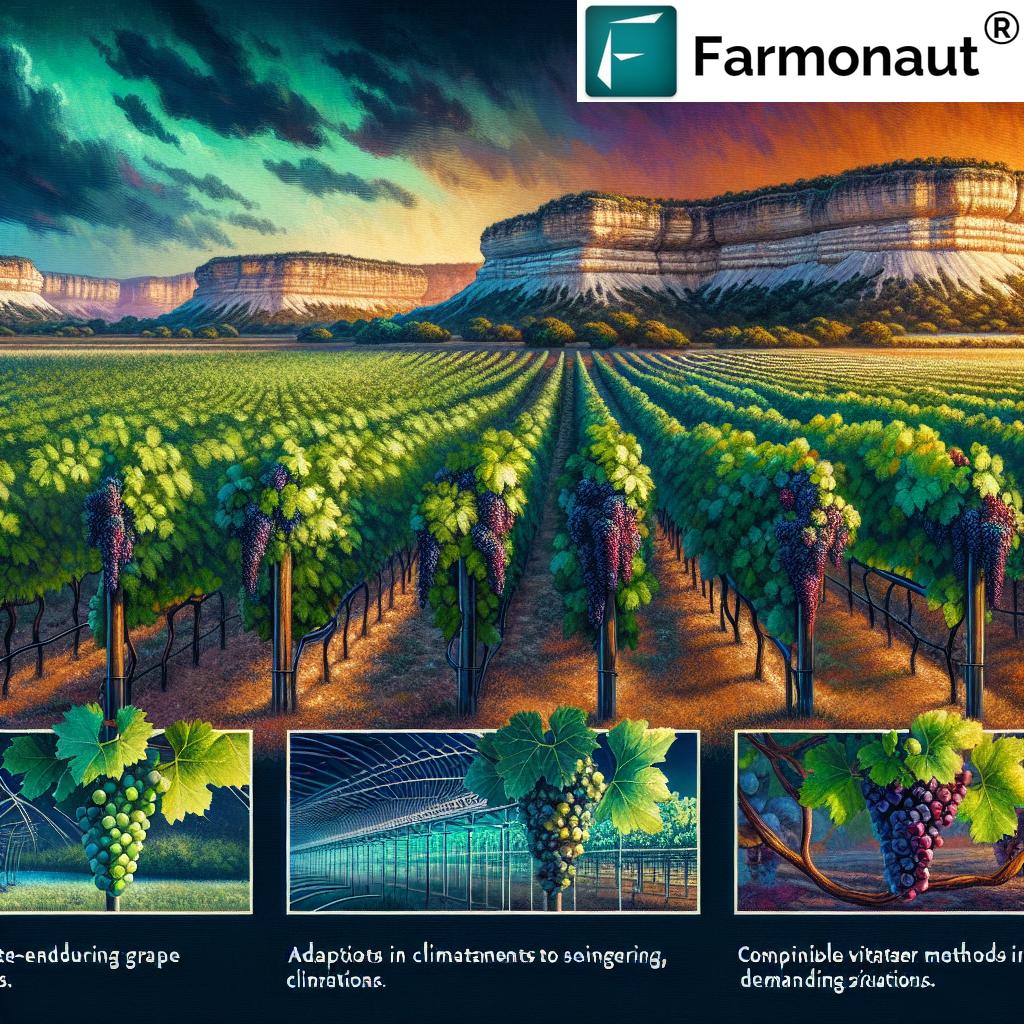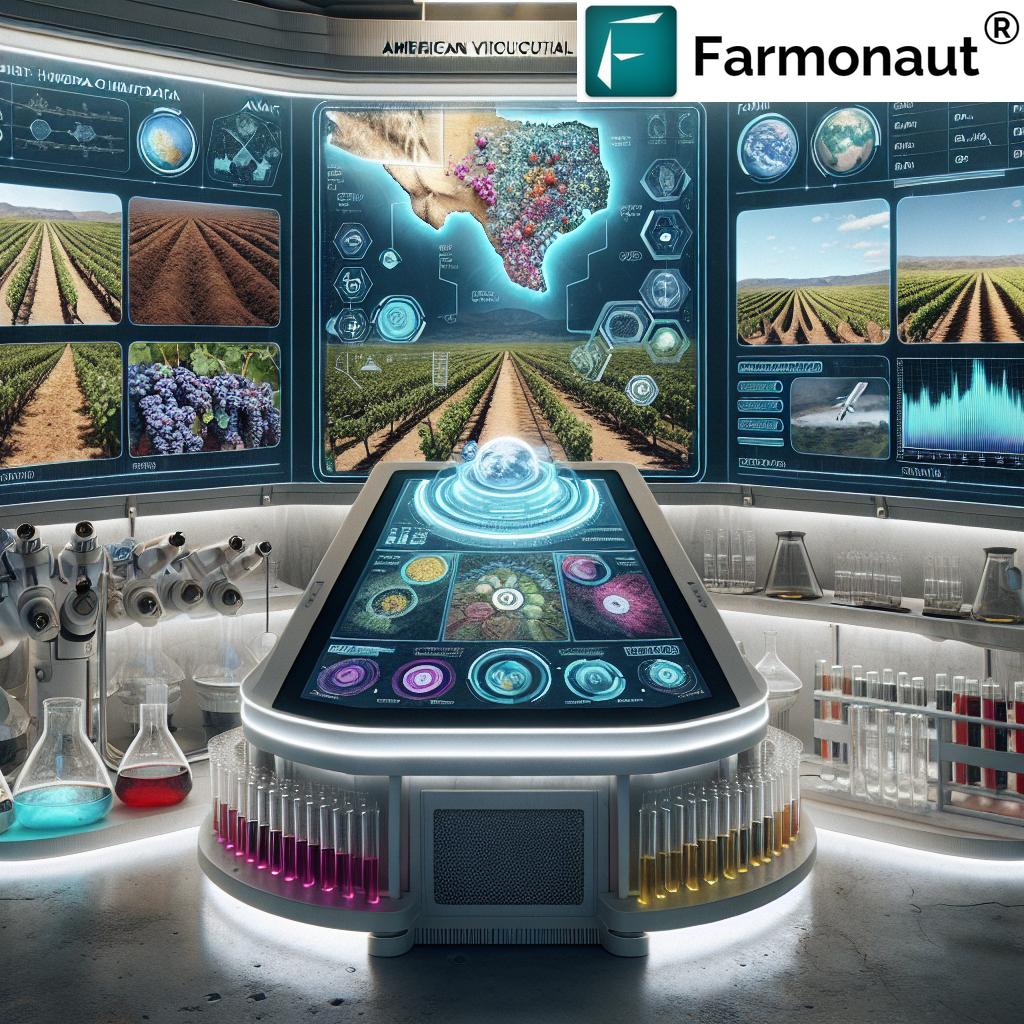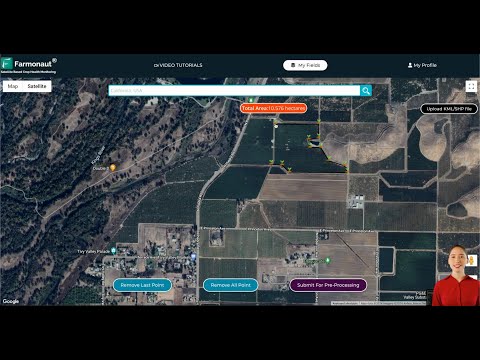Unlocking Texas Terroir: Innovative Viticulture Techniques for Climate-Resilient Grape Varieties
“Texas vineyards cultivate over 50 grape varieties, with 8 primary varieties accounting for 70% of production.”

Welcome to the fascinating world of Texas wine grapes, where innovation meets tradition in the heart of the Lone Star State. As we embark on this journey through the diverse landscape of Texas viticulture, we’ll explore the unique challenges and opportunities presented by the state’s distinctive terroir and climate. Our focus will be on uncovering the best grape varieties for hot climates and the innovative techniques that are shaping the future of wine production in this region.
Texas, with its vast expanse and varied topography, offers a unique canvas for viticulture. From the High Plains to the Hill Country, each region boasts its own microclimate and soil composition, contributing to the rich tapestry of Texas terroir characteristics. As we delve deeper into this subject, we’ll discover how growers are adapting to these conditions, utilizing cutting-edge technology and sustainable practices to produce world-class wines.
The Texas Wine Landscape: A Brief History
The history of wine production in Texas is as rich and varied as the state itself. While the first vineyard was planted by Franciscan priests in the 1650s, it wasn’t until the late 20th century that Texas began to emerge as a significant player in the American wine industry. Today, Texas stands proud as the fifth-largest wine-producing state in the U.S., with over 400 wineries dotting its landscape.
The journey to this point has been marked by challenges and triumphs. Early settlers brought European grape varieties to Texas, but many struggled in the harsh climate. It was the introduction of native and hybrid varieties that truly kickstarted the Texas wine industry. These hardier grapes, better suited to the state’s hot, dry climes, laid the foundation for what would become a thriving viticultural scene.
Understanding Texas Terroir
Terroir, a French term encompassing the environmental factors that affect a crop’s character, is crucial in viticulture. In Texas, this concept takes on unique dimensions due to the state’s diverse landscape and climate patterns.
- Soil Composition: Texas boasts a variety of soil types, with limestone being particularly prevalent. This calcium-rich soil contributes to the distinctive mineral notes found in many Texas wines.
- Climate: The state’s climate ranges from continental in the north to subtropical in the south. Hot summers and mild winters characterize most wine-growing regions, presenting both challenges and opportunities for viticulturists.
- Elevation: Texas vineyards are found at various elevations, from sea level to over 3,000 feet. These differences in altitude contribute to microclimates that influence grape growth and wine character.
Understanding and working with these unique terroir elements is key to producing high-quality, climate-resilient grapes in Texas.
Climate-Resilient Grape Varieties: The Backbone of Texas Viticulture
In the face of challenging climate conditions, Texas growers have turned to a range of climate resilient grape varieties that not only survive but thrive in the state’s hot, often dry environment. Let’s explore some of the key players in Texas viticulture:
Red Varieties
- Tempranillo: This Spanish variety has found a second home in Texas. Known for its early ripening (hence the name, which means “little early one” in Spanish), Tempranillo adapts well to Texas’s hot summers and produces wines with flavors of cherry, plum, and tobacco.
- Cabernet Sauvignon: While traditionally associated with cooler climates, certain clones of Cabernet Sauvignon have proven resilient in Texas. These grapes produce bold, structured wines with notes of blackberry and cassis.
- Mourvèdre: Originally from Spain, this variety thrives in hot, dry conditions. In Texas, it produces wines with rustic, earthy flavors and a hint of game.
- Sangiovese: This Italian variety adapts well to Texas terroir, producing wines with bright acidity and flavors of cherry and herbs.
White Varieties
- Viognier: This aromatic variety has found great success in Texas. It produces full-bodied whites with floral notes and flavors of peach and apricot.
- Blanc du Bois: A hybrid variety developed specifically for hot, humid climates, Blanc du Bois is resistant to Pierce’s disease, a significant threat to many grape varieties. It produces crisp, fruity wines with tropical notes.
- Roussanne: Another Mediterranean variety that adapts well to Texas conditions, Roussanne produces complex whites with notes of pear and honey.
- Marsanne: Often blended with Roussanne, this variety contributes body and texture to white wines, with flavors of melon and almond.
“Texas boasts 8 distinct wine-growing regions, each with unique terroir influenced by limestone-rich soils and warm climates.”
Innovative Viticulture Techniques for Texas Terroir
Adapting to the unique challenges presented by Texas terroir requires innovative approaches to viticulture. Here are some of the techniques being employed by Texas growers to produce high-quality, climate-resilient grapes:
Water Management
Water scarcity is a significant concern in many Texas wine regions. To address this, growers are implementing advanced water management techniques:
- Deficit Irrigation: This technique involves deliberately under-irrigating vines at specific growth stages to stress the plants, resulting in smaller, more concentrated berries.
- Drip Irrigation: Highly efficient drip systems deliver water directly to the vine roots, minimizing waste and evaporation.
- Soil Moisture Sensors: Advanced sensors help growers monitor soil moisture levels in real-time, allowing for precise irrigation scheduling.
At Farmonaut, we understand the critical importance of water management in viticulture. Our satellite-based crop health monitoring system provides valuable insights into soil moisture levels, helping growers make informed decisions about irrigation. By leveraging our technology, vineyard managers can optimize water usage while ensuring the health and productivity of their vines.
Canopy Management
Proper canopy management is crucial in hot climates to protect grapes from excessive sun exposure while ensuring adequate airflow:
- Vertical Shoot Positioning (VSP): This training system helps manage vigor and improves air circulation, reducing disease pressure.
- Leaf Pulling: Selective removal of leaves around grape clusters can help control temperature and humidity in the fruit zone.
- Shoot Thinning: Removing excess shoots helps balance the vine’s energy distribution and improves fruit quality.
Soil Management
Maintaining healthy soils is key to producing quality grapes. Texas growers are employing various vineyard soil management techniques:
- Cover Crops: Planting cover crops between vine rows helps prevent erosion, improves soil structure, and can even provide habitat for beneficial insects.
- Compost Application: Regular addition of organic matter helps improve soil structure and water retention.
- Minimal Tillage: Reducing soil disturbance helps preserve soil structure and beneficial microorganisms.
Viticultural Regions in Texas
Texas is home to several distinct viticultural regions, each with its own unique characteristics:
- Texas High Plains AVA: Located in the Texas Panhandle, this region is known for its high elevation and continental climate. It’s the largest wine grape growing region in the state, producing about 80% of Texas’s wine grapes.
- Texas Hill Country AVA: The second-largest AVA in Texas, this region is characterized by its rolling hills and limestone soils. It’s particularly well-suited to Mediterranean varieties.
- Texas Davis Mountains AVA: This high-elevation region in West Texas benefits from cooler temperatures and low humidity, ideal for producing high-quality grapes.
- Texoma AVA: Located along the Red River, this region has a long growing season and is known for its Cabernet Sauvignon and Syrah.

Sustainable Viticulture Practices in Texas
As climate change continues to impact agriculture worldwide, Texas growers are increasingly turning to sustainable viticulture practices to ensure the long-term viability of their vineyards:
- Integrated Pest Management (IPM): This approach combines biological, cultural, and chemical methods to manage pests and diseases while minimizing environmental impact.
- Renewable Energy: Many wineries are incorporating solar panels and wind turbines to reduce their carbon footprint.
- Water Recycling: Implementing systems to capture and reuse water from winery operations helps conserve this precious resource.
- Biodiversity Promotion: Encouraging native plant species and wildlife habitats around vineyards helps create a balanced ecosystem.
At Farmonaut, we’re committed to supporting sustainable agriculture practices. Our AI-based advisory system, Jeevn AI, provides personalized recommendations to help growers implement sustainable practices tailored to their specific vineyard conditions.
Explore Farmonaut’s API for advanced agricultural insights
The Role of Technology in Texas Viticulture
Technology plays a crucial role in modern viticulture, especially in challenging climates like Texas. Here are some key technological advancements shaping the industry:
- Remote Sensing: Satellite and drone imagery provide valuable data on vine health, soil conditions, and water stress.
- Weather Stations: On-site weather monitoring helps growers make informed decisions about irrigation, pest management, and harvest timing.
- Precision Viticulture: GPS-guided equipment allows for precise application of inputs, reducing waste and improving efficiency.
- Data Analytics: Advanced software helps growers analyze and interpret the vast amounts of data collected from various sources, enabling more informed decision-making.
Farmonaut’s satellite-based crop health monitoring system is at the forefront of this technological revolution in agriculture. By providing real-time data on vegetation health (NDVI) and soil moisture levels, we empower growers to make data-driven decisions that optimize their vineyard management practices.
The Future of Texas Viticulture
As we look to the future, several trends are shaping the trajectory of Texas viticulture:
- Climate Change Adaptation: Ongoing research into heat-tolerant varieties and innovative cooling techniques will be crucial as temperatures continue to rise.
- Precision Viticulture: The integration of AI and machine learning in vineyard management will allow for even more precise and efficient growing practices.
- Sustainability Focus: As consumers become more environmentally conscious, sustainable and organic wine production will likely increase in importance.
- Varietal Experimentation: Texas growers will continue to explore new varieties that are well-suited to the state’s unique terroir, potentially developing new hybrid varieties specifically for Texas conditions.
Wine Grape Growing Techniques for Texas Conditions
Successfully growing wine grapes in Texas requires a combination of traditional viticultural knowledge and innovative techniques adapted to the state’s unique conditions. Here are some key wine grape growing techniques employed by Texas vintners:
- Site Selection: Choosing the right location is crucial. Factors such as elevation, slope, and proximity to water sources all play a role in creating the ideal microclimate for grape cultivation.
- Rootstock Selection: Using rootstocks that are resistant to pests, diseases, and drought conditions common in Texas can significantly improve vine health and longevity.
- Trellising Systems: Implementing appropriate trellising systems helps manage vine vigor, improve air circulation, and optimize sun exposure. The Geneva Double Curtain (GDC) system, for example, is popular in some Texas vineyards for its ability to increase yield and improve fruit quality.
- Frost Protection: While not as common as heat stress, late spring frosts can be a concern in some Texas wine regions. Techniques such as wind machines and overhead sprinkler systems are used to protect vulnerable young shoots.
- Harvest Timing: Precise timing of harvest is critical to achieving optimal grape quality. Many Texas growers conduct night harvests to preserve fruit freshness in the hot climate.
At Farmonaut, we understand the complexities of grape cultivation in challenging climates. Our technology provides growers with valuable insights into their vineyard’s health and environmental conditions, enabling them to make informed decisions about these crucial growing techniques.
Access Farmonaut’s API Developer Docs for in-depth agricultural data
The Unique Flavors of Texas Wines
The distinctive terroir and climate of Texas, combined with the innovative techniques employed by its vintners, result in wines with unique flavor profiles. Here are some characteristics often associated with Texas wines:
- Bold Reds: Texas red wines are often characterized by their full body and intense fruit flavors. Cabernet Sauvignon from Texas, for example, may exhibit strong blackberry and black currant notes with a hint of leather.
- Aromatic Whites: White varieties like Viognier produce wines with pronounced floral aromas and stone fruit flavors, often with a rich, creamy texture due to the warm climate.
- High Alcohol Content: The hot Texas climate often results in grapes with high sugar content, which translates to higher alcohol levels in the finished wines.
- Mineral Notes: The limestone-rich soils in many Texas wine regions can impart distinct mineral qualities to the wines, adding complexity to their flavor profiles.
Table: Texas Wine Grape Varieties and Climate Resilience
| Grape Variety | Climate Resilience Rating (1-5) | Preferred Texas Region | Soil Type | Water Requirements | Notable Characteristics |
|---|---|---|---|---|---|
| Tempranillo | 4 | Texas Hill Country | Limestone, Sandy Loam | Low to Moderate | Early ripening, cherry and tobacco notes |
| Cabernet Sauvignon | 3 | Texas High Plains | Well-drained, Gravel | Moderate | Full-bodied, blackberry and cassis flavors |
| Viognier | 4 | Texas Hill Country | Limestone, Clay | Low to Moderate | Aromatic, peach and apricot notes |
| Blanc du Bois | 5 | Gulf Coast | Sandy, Well-drained | Moderate to High | Disease-resistant, tropical fruit flavors |
| Mourvèdre | 4 | Texas High Plains | Sandy, Gravel | Low | Heat-tolerant, earthy and gamey notes |
Frequently Asked Questions
- What are the best grape varieties for hot climates like Texas?
Some of the best grape varieties for hot climates include Tempranillo, Mourvèdre, Viognier, and Blanc du Bois. These varieties have shown excellent resilience to heat and drought conditions common in Texas. - How does Texas terroir affect wine production?
Texas terroir, characterized by limestone-rich soils, hot summers, and varying elevations, contributes to wines with bold flavors, high alcohol content, and often distinctive mineral notes. - What innovative techniques are Texas vintners using to combat climate challenges?
Texas vintners are employing techniques such as deficit irrigation, advanced canopy management, and the use of heat-tolerant rootstocks. They’re also leveraging technology like satellite imagery and precision viticulture to optimize grape growing. - How is sustainable viticulture being practiced in Texas?
Sustainable practices in Texas viticulture include integrated pest management, water conservation techniques, the use of renewable energy in wineries, and promoting biodiversity in and around vineyards. - What role does technology play in Texas viticulture?
Technology plays a crucial role through the use of remote sensing, weather stations, precision viticulture techniques, and data analytics. These tools help growers make informed decisions about vineyard management.
Conclusion
The world of Texas wine grapes is a testament to the power of innovation and resilience in the face of challenging climatic conditions. From the selection of climate-resilient grape varieties to the implementation of cutting-edge viticulture techniques, Texas vintners are carving out a unique niche in the global wine industry.
As we’ve explored, the combination of Texas’s distinctive terroir, innovative growing practices, and the dedication of its wine community has resulted in wines that are truly reflective of the Lone Star State’s spirit. The future of Texas viticulture looks bright, with ongoing research and technological advancements promising even greater achievements in wine quality and sustainability.
At Farmonaut, we’re proud to be part of this exciting journey, providing technology-driven solutions that support the growth and sustainability of Texas viticulture. By leveraging our satellite-based crop health monitoring and AI-driven advisory systems, growers can make more informed decisions, optimize their resources, and contribute to the ongoing success story of Texas wines.
As we raise a glass to the ingenuity of Texas vintners, we look forward to the continued evolution of this dynamic industry. Here’s to the future of Texas wines – bold, innovative, and unmistakably Texan!







